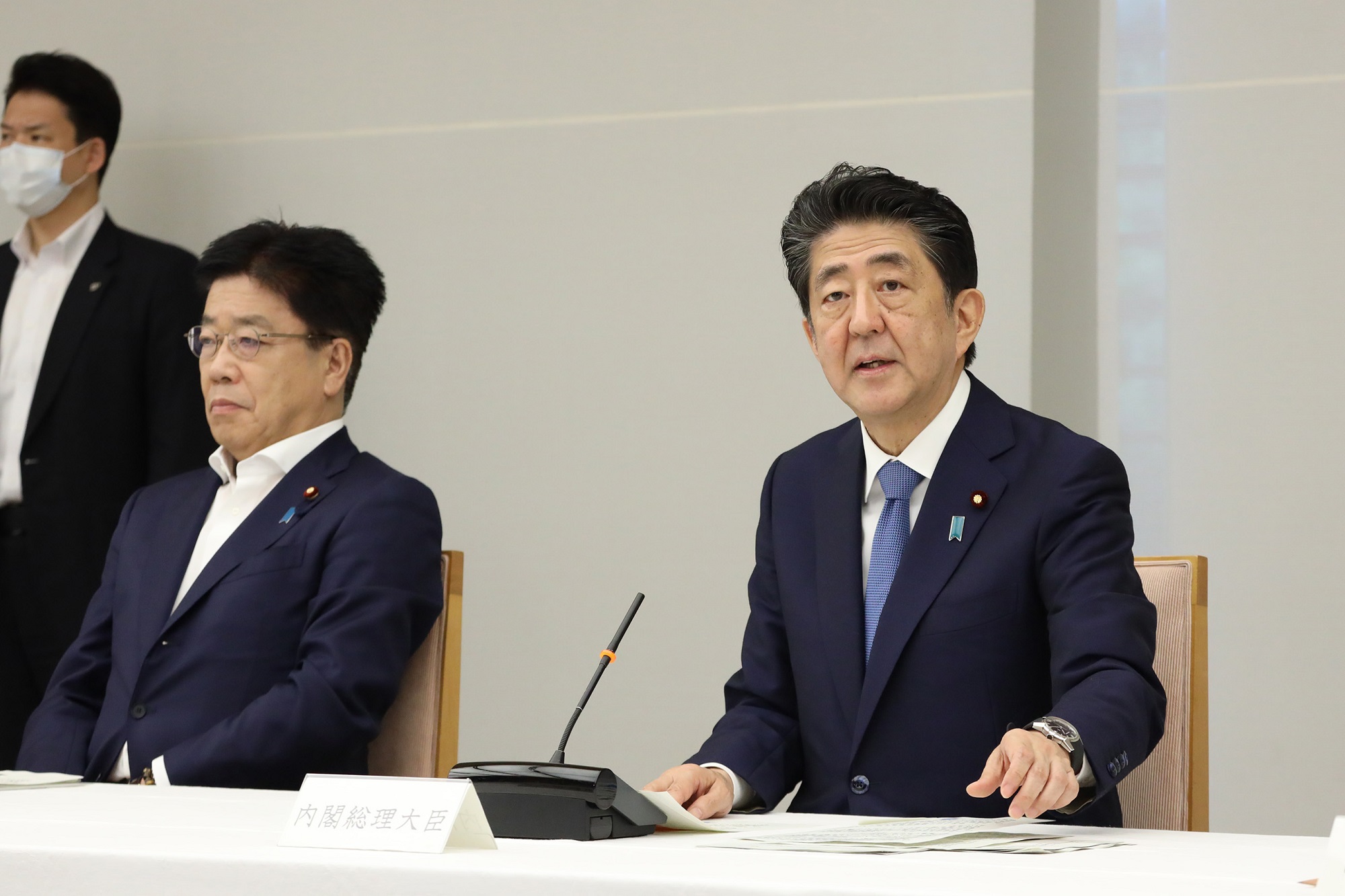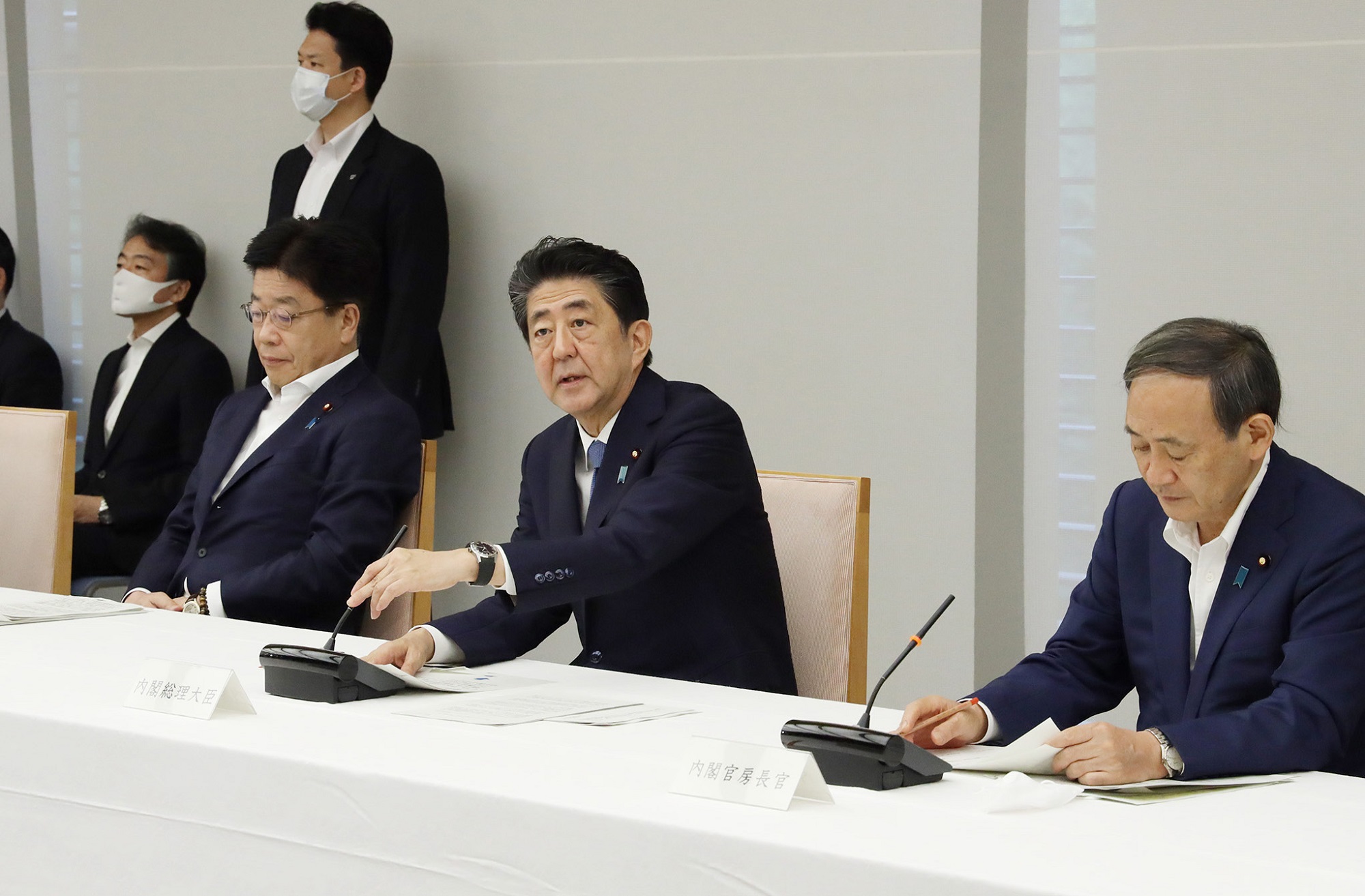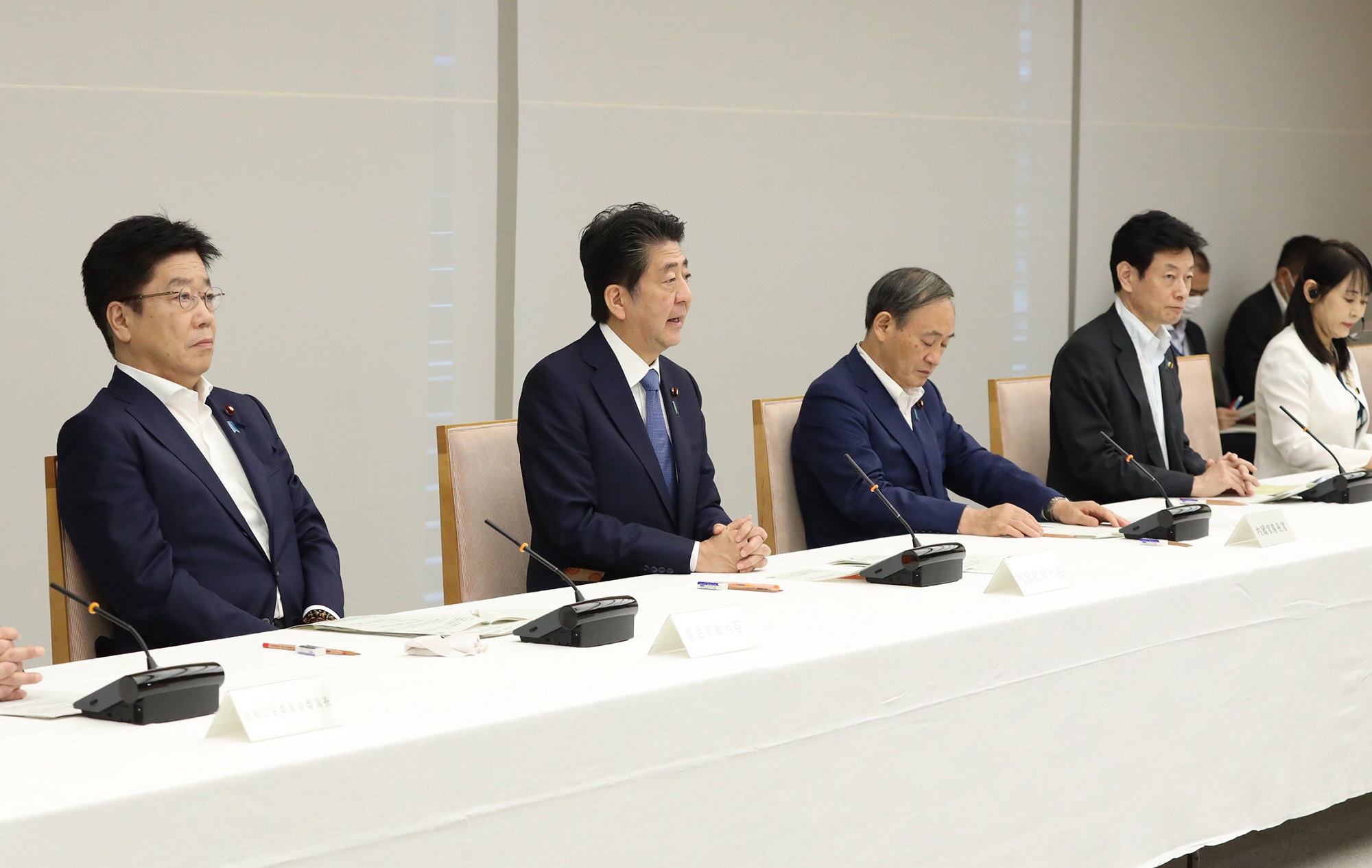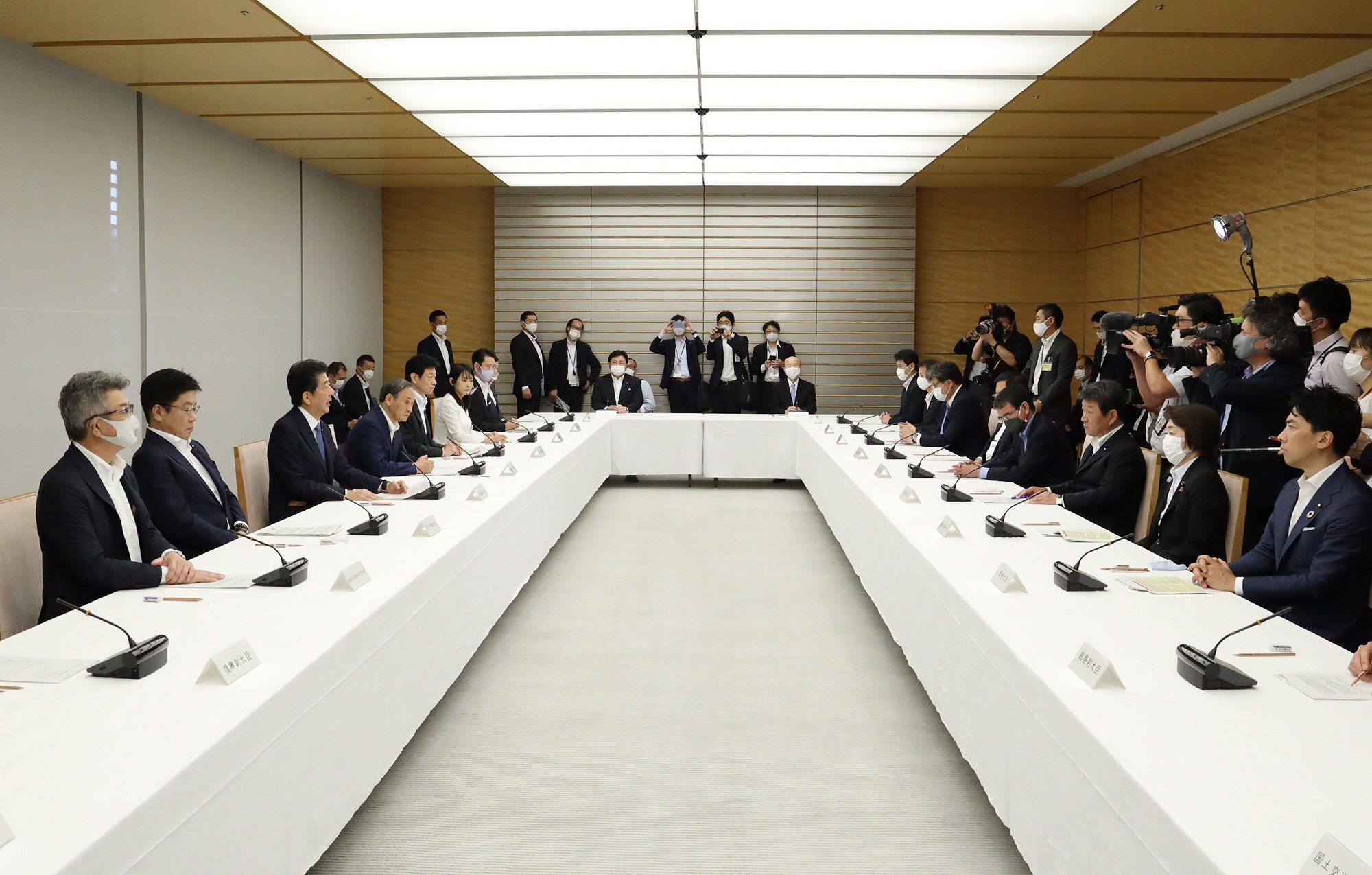Home > News > The Prime Minister in Action > August 2020 > 42nd Meeting of the Novel Coronavirus Response Headquarters
The Prime Minister in Action
42nd Meeting of the Novel Coronavirus Response Headquarters
August 28, 2020

Photograph of the Prime Minister making a statement (1)
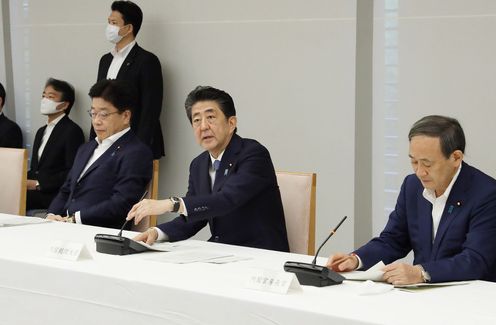
Photograph of the Prime Minister making a statement (2)

Photograph of the Prime Minister making a statement (3)
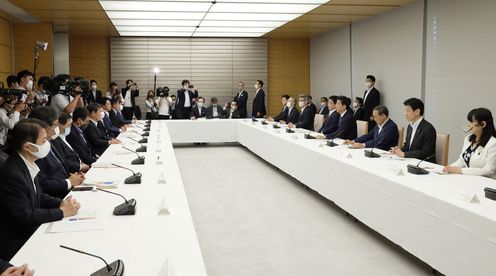
Photograph of the Prime Minister making a statement (4)
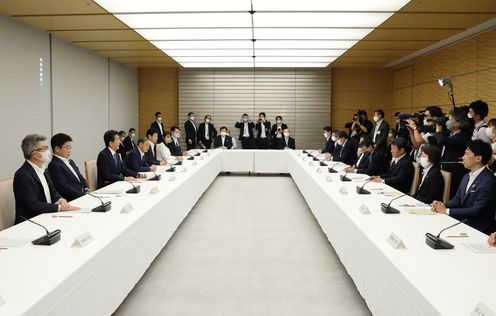
Photograph of the Prime Minister making a statement (5)
On August 28, 2020, the Prime Minister held the 42nd meeting of the Novel Coronavirus Response Headquarters at the Prime Minister’s Office.
At the meeting, the participants discussed the response to the novel coronavirus disease (COVID-19).
Following the discussion, the Prime Minister said,
“Today, anticipating the coming seasonal influenza period, we have formulated a new direction for the novel coronavirus disease (COVID-19) countermeasures.
Based on the knowledge accumulated thus far, the experts have confirmed that the strategy to avoid the three Cs (closed spaces, crowded places, and close contact settings), adhere to a new mode of daily life, and take effective measures corresponding to respective risks can balance the prevention of the spread of infections and socio-economic activities, while minimizing the number of deaths and patients with severe symptoms.
It has also been confirmed that, while 80% of patients make a recovery, with only developing mild or no symptoms, the elderly and persons with underlying conditions face a high risk of developing severe symptoms. Therefore, measures targeting at those individuals are the key to save as many lives as possible.
The surge in infections from July is currently shifting to a declining trend. However, it is expected that, during the seasonal influenza period, there will be a significant increase in the number of people experiencing symptoms such as fever, resulting in a rapid increase in demand for testing and medical care. To prepare for this, we must swiftly put the necessary measures in place from now. We intend to work on further securing screening and medical treatment structures as well as prioritize medical resources for people at high risk of developing severe symptoms taking into account our experience to date.
First and foremost, we will review the authority set out in the Act on the Prevention of Infectious Diseases and Medical Care for Patients with Infectious Diseases, from the perspective of prioritizing medical resources for patients with severe symptoms. COVID-19 is currently considered equivalent to a Class II Infectious Disease, examples of which include tuberculosis and severe acute respiratory syndrome (SARS), or higher. In order to reduce the burden on public health centers and medical institutions, and to ensure the more efficient use of hospital beds, we will review the application of the current arrangement, including amending the relevant government ordinances.
Regarding screening structures, in order to simultaneously screen for COVID-19 and influenza, we intend to fundamentally enhance the structures, including securing the capacity to conduct an average of 200,000 tests per day at regional medical institutions.
In areas experiencing the spread of infections, we will implement regular screening all at once for all those who work at medical institutions and care facilities for the elderly so as to prevent group infections among people at high risk of developing severe symptoms.
Furthermore, preparing for the partial and gradual resumption of the international movement of people, we will make all possible efforts to secure screening capacity for over 10,000 people at Narita Airport, Haneda Airport and Kansai International Airport by next month, and further advance the preparation of the necessary screening structures at other airports as well.
With respect to the medical treatment structures, respective prefectural governments will steadily advance the preparation of hospital beds and other accommodation facilities based on the relevant plans. The government intends to thoroughly provide necessary fiscal support for implementation.
We will also provide additional support to ensure the stable management of medical institutions that accept COVID-19 patients, and put in place a structure to ensure that people who develop symptoms such as fever can seek consultation, diagnosis and treatment from their respective primary care doctor directly.
Moreover, by further strengthening the structures of public health centers and crisis management, we intend to secure sufficient medical treatment structures even during the seasonal influenza period.
With regard to vaccines, aiming to secure the amount necessary to cover the entire population of Japan before the end of the first half of next year, we intend to advance the signing of contracts to receive a supply of vaccines whose safety and effectiveness are confirmed, no matter if they are manufactured in Japan or abroad.
In addition, while accelerating the research and development of therapeutic medicine, we will strongly advance the development of new technologies and innovations in Japan. By doing so, we will steadily restore our everyday life in a new form, which controls infections and promotes socio-economic activities.
Going forward, by utilizing contingency funds and advancing these efforts swiftly, we intend to expeditiously implement future countermeasures, which anticipate the shift from summer to autumn and the arrival of winter.
Concerning the special measures such as the raising of the upper limit of the Employment Adjustment Subsidies to 15,000 yen, which is to expire at the end of September, in light of the current employment conditions and other factors, we will extend the expiration date to the end of December.
Besides these measures, while continuing to thoroughly implement existing border controls and measures to prevent the spread of infections, we will resume the international movement of people.
For foreign nationals with statuses of residence in Japan, on the condition of adopting additional quarantine measures, those who depart Japan will be allowed to reenter the country. We will also allow those who have already departed Japan for areas from which we will deny entry to reenter Japan from those areas.
I ask each of you to continue your utmost effort to implement these measures, while working together with business operators and local governments, so as to promote socio-economic activities while minimizing the spread of infections as much as possible.”
At the meeting, the participants discussed the response to the novel coronavirus disease (COVID-19).
Following the discussion, the Prime Minister said,
“Today, anticipating the coming seasonal influenza period, we have formulated a new direction for the novel coronavirus disease (COVID-19) countermeasures.
Based on the knowledge accumulated thus far, the experts have confirmed that the strategy to avoid the three Cs (closed spaces, crowded places, and close contact settings), adhere to a new mode of daily life, and take effective measures corresponding to respective risks can balance the prevention of the spread of infections and socio-economic activities, while minimizing the number of deaths and patients with severe symptoms.
It has also been confirmed that, while 80% of patients make a recovery, with only developing mild or no symptoms, the elderly and persons with underlying conditions face a high risk of developing severe symptoms. Therefore, measures targeting at those individuals are the key to save as many lives as possible.
The surge in infections from July is currently shifting to a declining trend. However, it is expected that, during the seasonal influenza period, there will be a significant increase in the number of people experiencing symptoms such as fever, resulting in a rapid increase in demand for testing and medical care. To prepare for this, we must swiftly put the necessary measures in place from now. We intend to work on further securing screening and medical treatment structures as well as prioritize medical resources for people at high risk of developing severe symptoms taking into account our experience to date.
First and foremost, we will review the authority set out in the Act on the Prevention of Infectious Diseases and Medical Care for Patients with Infectious Diseases, from the perspective of prioritizing medical resources for patients with severe symptoms. COVID-19 is currently considered equivalent to a Class II Infectious Disease, examples of which include tuberculosis and severe acute respiratory syndrome (SARS), or higher. In order to reduce the burden on public health centers and medical institutions, and to ensure the more efficient use of hospital beds, we will review the application of the current arrangement, including amending the relevant government ordinances.
Regarding screening structures, in order to simultaneously screen for COVID-19 and influenza, we intend to fundamentally enhance the structures, including securing the capacity to conduct an average of 200,000 tests per day at regional medical institutions.
In areas experiencing the spread of infections, we will implement regular screening all at once for all those who work at medical institutions and care facilities for the elderly so as to prevent group infections among people at high risk of developing severe symptoms.
Furthermore, preparing for the partial and gradual resumption of the international movement of people, we will make all possible efforts to secure screening capacity for over 10,000 people at Narita Airport, Haneda Airport and Kansai International Airport by next month, and further advance the preparation of the necessary screening structures at other airports as well.
With respect to the medical treatment structures, respective prefectural governments will steadily advance the preparation of hospital beds and other accommodation facilities based on the relevant plans. The government intends to thoroughly provide necessary fiscal support for implementation.
We will also provide additional support to ensure the stable management of medical institutions that accept COVID-19 patients, and put in place a structure to ensure that people who develop symptoms such as fever can seek consultation, diagnosis and treatment from their respective primary care doctor directly.
Moreover, by further strengthening the structures of public health centers and crisis management, we intend to secure sufficient medical treatment structures even during the seasonal influenza period.
With regard to vaccines, aiming to secure the amount necessary to cover the entire population of Japan before the end of the first half of next year, we intend to advance the signing of contracts to receive a supply of vaccines whose safety and effectiveness are confirmed, no matter if they are manufactured in Japan or abroad.
In addition, while accelerating the research and development of therapeutic medicine, we will strongly advance the development of new technologies and innovations in Japan. By doing so, we will steadily restore our everyday life in a new form, which controls infections and promotes socio-economic activities.
Going forward, by utilizing contingency funds and advancing these efforts swiftly, we intend to expeditiously implement future countermeasures, which anticipate the shift from summer to autumn and the arrival of winter.
Concerning the special measures such as the raising of the upper limit of the Employment Adjustment Subsidies to 15,000 yen, which is to expire at the end of September, in light of the current employment conditions and other factors, we will extend the expiration date to the end of December.
Besides these measures, while continuing to thoroughly implement existing border controls and measures to prevent the spread of infections, we will resume the international movement of people.
For foreign nationals with statuses of residence in Japan, on the condition of adopting additional quarantine measures, those who depart Japan will be allowed to reenter the country. We will also allow those who have already departed Japan for areas from which we will deny entry to reenter Japan from those areas.
I ask each of you to continue your utmost effort to implement these measures, while working together with business operators and local governments, so as to promote socio-economic activities while minimizing the spread of infections as much as possible.”

